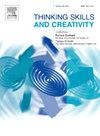多元分析探讨不同复杂程度的协同知识建构任务中学习者学习过程的差异
IF 3.7
2区 教育学
Q1 Social Sciences
引用次数: 0
摘要
协作学习在教育领域受到越来越多的关注。小组成员的协作知识构建对成功的协作学习起着重要的作用。已有证据证明了学习者协作的内隐性,以及复杂程度不同的任务可以促进学习者不同方面认知能力的发展。因此,我们结合外显行为和内隐生理指标,研究了不同复杂程度任务下学习者协作知识构建过程的差异。本研究采用内容分析、基于脑电图(EEG)的超扫描技术和认知网络分析(ENA)对28名参与两个30分钟在线协作任务的三合会进行数据分析。从频率结果来看,学习者在协同设计任务中的提问和计划(TaskPlan)行为显著高于协同概念解释任务。ENA的结果进一步表明,与协同概念解释任务相比,协同设计任务中提问与相互理解、规划(SociPlan)与相互理解、监控(SociMoni)与相互理解之间的连通性系数都更高。此外,脑电数据显示,学习者在协同设计任务中的脑间同步性高于协同概念解释任务。综合多个数据分析表明,在协同概念解释任务中,学习者更强调概念的理解和构建,而在协同设计任务中,学习者更重视团队成员之间的社会互动,这需要更多的提问和规划行为。研究结果有助于教师理解不同复杂任务的协作学习过程。他们也可以给予学习者更专业的指导和支持。本文章由计算机程序翻译,如有差异,请以英文原文为准。
Exploring differences in learners' learning processes across collaborative knowledge construction tasks of diverse complexity: A multiple analysis
A growing amount of attention has been paid to collaborative learning in the field of education. Group members' collaborative knowledge construction plays an important role in successful collaborative learning. Evidence has proven the implicit character of learners' collaboration and the fact that tasks of diverse complexity can promote the development of learners' cognitive abilities in different aspects. So we investigated how learners' collaborative knowledge construction processes varied across tasks of diverse complexity levels, combining explicit behavior with implicit physiological indicators. This study used content analysis, hyperscanning technology based on electroencephalograms (EEG), and epistemic network analysis (ENA) to analyze the data of 28 triads who participated in two 30-minute online collaborative tasks. According to the frequency results, learners' asking questions and planning (TaskPlan) behaviors in collaborative design tasks are significantly higher than those in collaborative concept explanation tasks. The ENA results further demonstrate that, in comparison to collaborative concept explanation tasks, the connectivity coefficients between asking questions and mutual understanding, planning (SociPlan) and mutual understanding, alongside monitoring (SociMoni) and mutual understanding are all higher in collaborative design tasks. Additionally, EEG data show that learners had higher inter-brain synchronization in the collaborative design task compared to the collaborative concept explanation task. The comprehensive analysis of multiple data points to the fact that in collaborative concept explanation tasks, learners place greater emphasis on the comprehension and construction of concepts, while in collaborative design tasks, learners attach more importance to social interactions among team members which calls for more asking questions and planning behaviors. The research findings can help teachers understand the collaborative learning processes of diverse complexity tasks. They can also give learners more specialized guidance and support accordingly.
求助全文
通过发布文献求助,成功后即可免费获取论文全文。
去求助
来源期刊

Thinking Skills and Creativity
EDUCATION & EDUCATIONAL RESEARCH-
CiteScore
6.40
自引率
16.20%
发文量
172
审稿时长
76 days
期刊介绍:
Thinking Skills and Creativity is a new journal providing a peer-reviewed forum for communication and debate for the community of researchers interested in teaching for thinking and creativity. Papers may represent a variety of theoretical perspectives and methodological approaches and may relate to any age level in a diversity of settings: formal and informal, education and work-based.
 求助内容:
求助内容: 应助结果提醒方式:
应助结果提醒方式:


